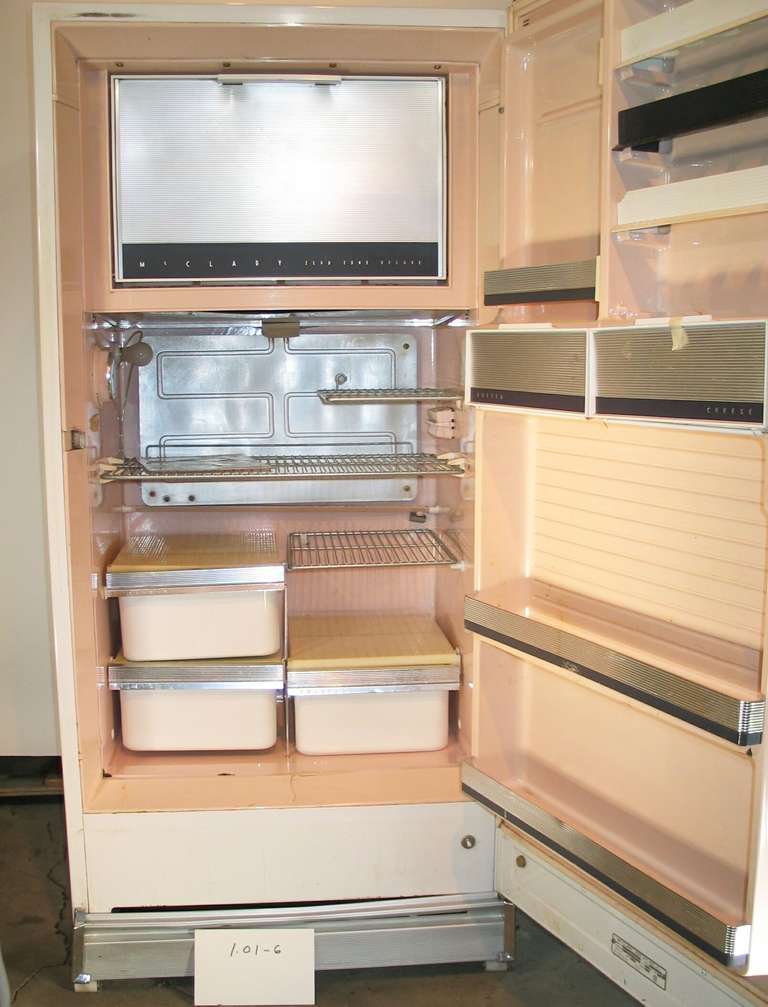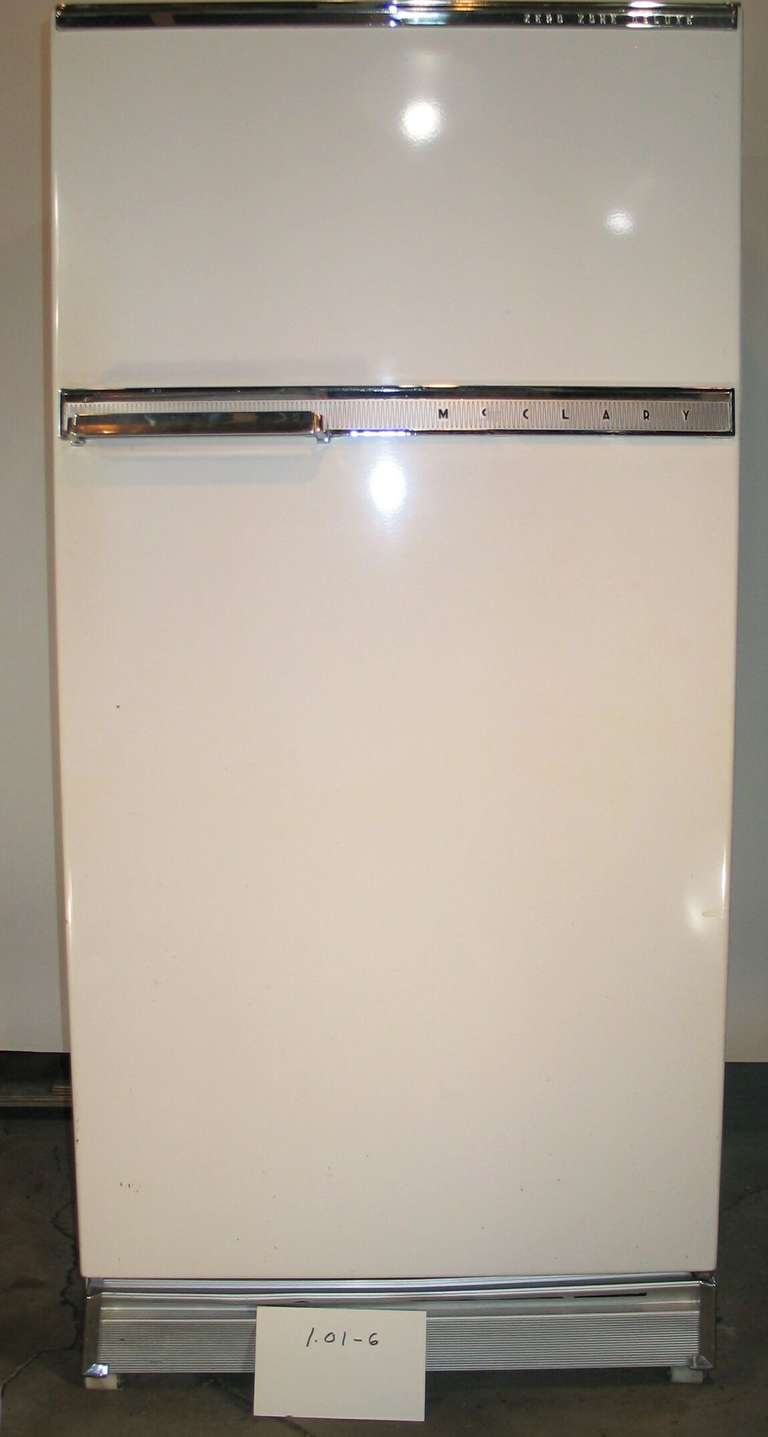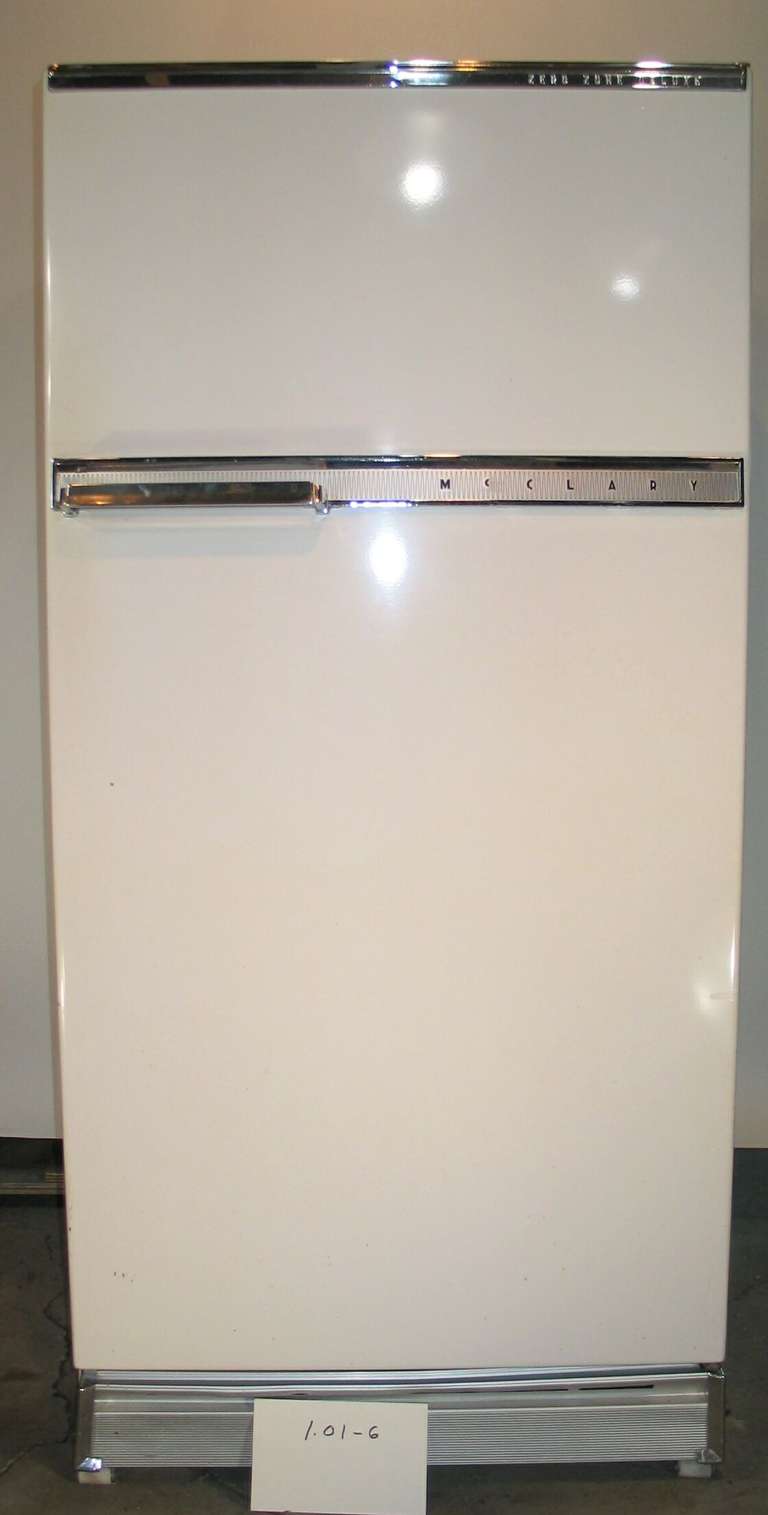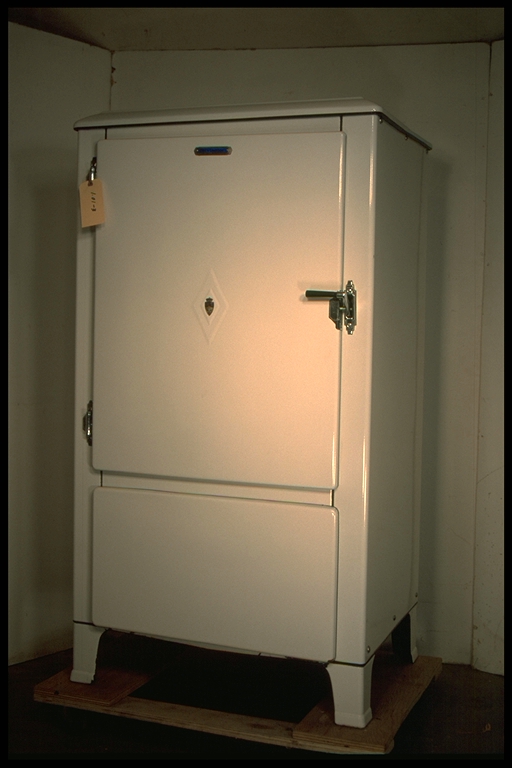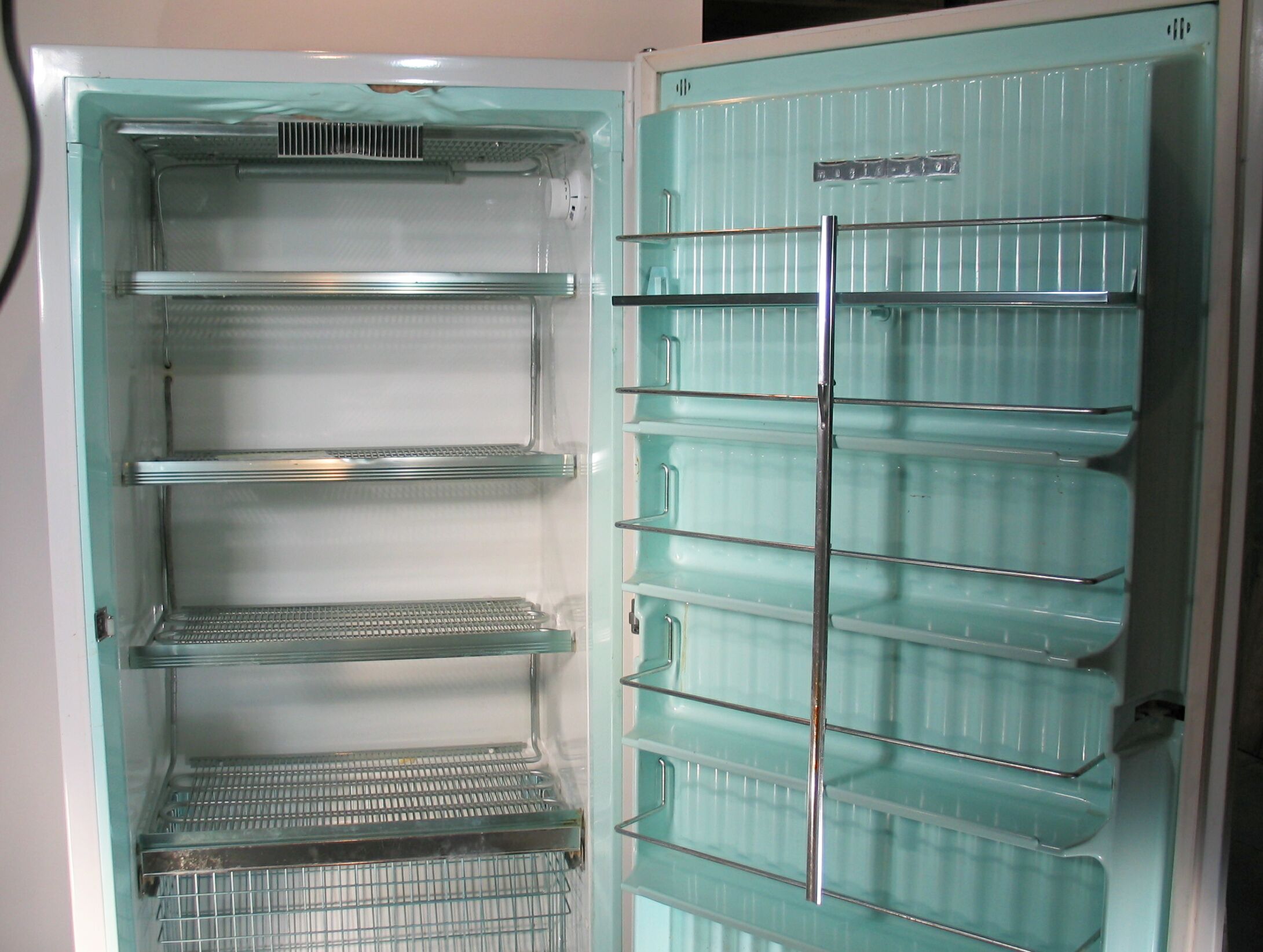1.01-6: Mcclary, 1958 Cabinet Refrigerator with Food Freezing Compartment
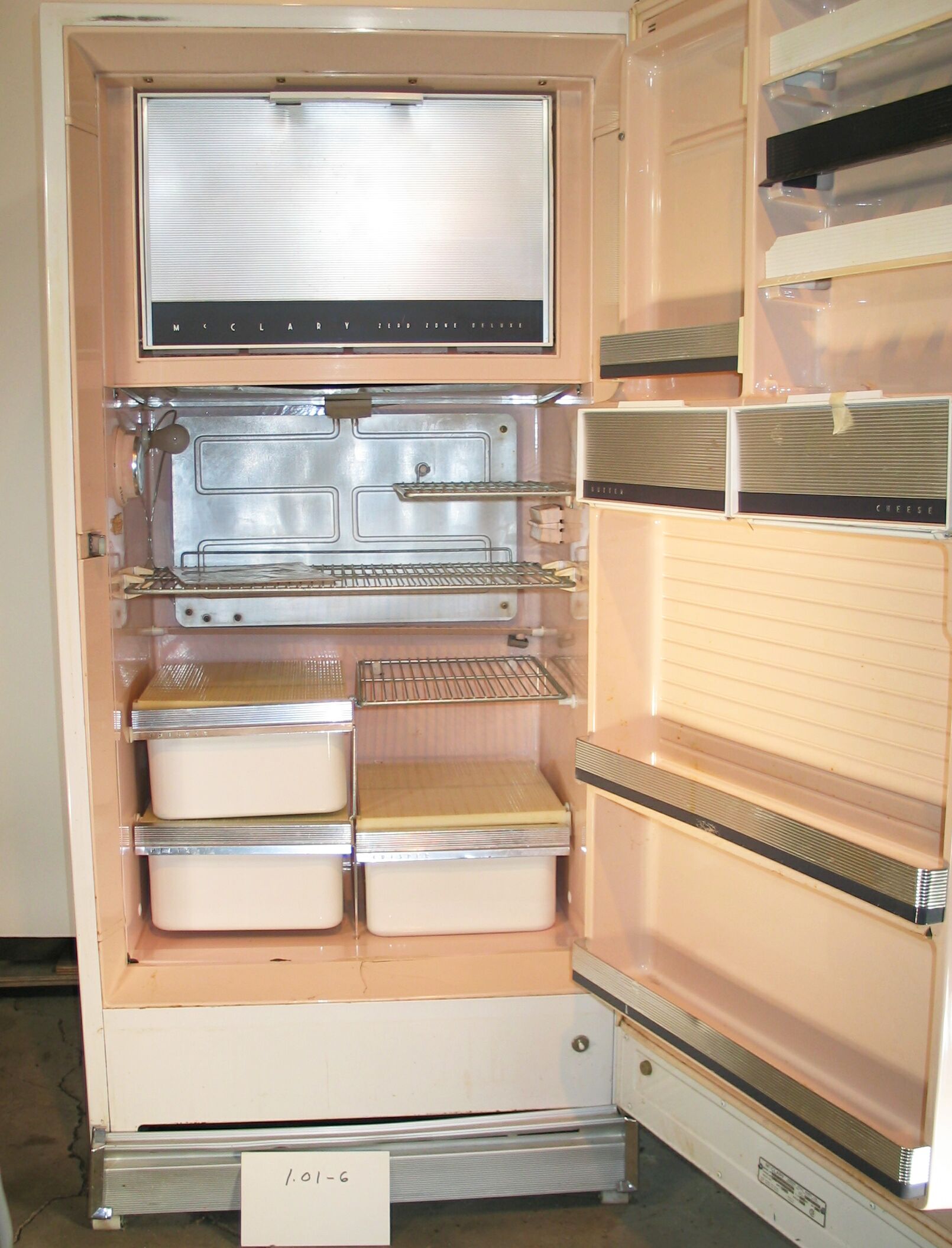
| HHCC Accession No. 2003.004 | HHCC Classification Code: 1.01-6 |
|---|
Description:
Household, 13 cubic Foot Refrigerator with Food Freezing Compartment, McClary, 1958
Group:
1.01 Unitary Refrig and A/C Equipment and Systems - Household Cabinet Refrigerators
Make:
McClary,
Manufacturer:
Kelvinator of Canada, London Ontario for General Steel Wares
Model:
ZD13-85-1,
Serial No.:
F530121-8
Size:
30x 25x 63
Weight:
Circa:
1958
Rating:
Exhibit Quality, Excellent example of the genre
Patent Date/Number:
Canadian Patent 386,045 to 518,980; US Patent 1,886,601 to 2,724,628
Provenance:
From York County (York Region) Ontario, once a rich agricultural hinterlands, attracting early settlement in the last years of the 18th century. Located on the north slopes of the Oak Ridges Moraine, within 20 miles of Toronto, the County would also attract early ex-urban development, to be come a wealthy market place for the emerging household and consumer technologies of the early and mid 20th century.
This artifact was sold in 1958 by T. H. Oliver, Refrigeration and Electric Sales and Service, Aurora, Ontario [an early worker in the field of agricultural, industrial and consumer technology],to a household application at 81 spruce St Aurora. It was in continuous service to the owner for over 42 years and is still fully operable.
Type and Design:
Operating system, compression refrigeration type, theoretical Carnot cycle. Design: unitary design and construction with insulated refrigerated cabinet, Evaporator and capillary line flow control and self-contained refrigerant condensing unit, sealed hermetic design, electric motor driven.
Construction:
Equipped with separate insulated freezer compartment and refrigerated plate for cooling the main food compartment, metal plate, vertical, rear mounted stack condenser.
This machine stands as a model of Post-World War II construction. The wooden framing, natural cork insulation and bolted steel panel construction of 1930’s was gone to be by bolt-less formed steel construction, with wool fiber insulation and streamlined, child-proof hardware .
Material:
Original white enamel finish speaks well of the coating technology of the period, with out the yelowing and cracking of pre WWII paint technology
Special Features:
Modern Post World War II design, reminiscent of the design idiom of the day, Moving from the curved lines of the pre-war Art Deco period New child-proof safety door lock, response to the loss of life by chidden and the safety promotions taken up by the industry itself ( See early examples of industry safety promotions)
Accessories:
: Activated Carbon air purifier offered by McClary as a sales feature to a public increasingly expecting new sales features ‘ a major incentive of the industry to encourage second time buyers. The second time buyer was critical to stimulating the post WWII industrial economy.
Original owner’s manual and recipe book
Capacities:
1/5 HP, 2.8 amp, F12 10.5 oz
Performance Characteristics:
Cracked plastic parts evident on the interior of the cabinet are an indicator of the early plastic’s technology of the time. Here hardening and cracking were part of the experience of the period
Operation:
Control and Regulation:
Automatic temperature control of food compartment, operates on refrigerant “slop over” principle for food compartment providing automatic defrost, with freezer comparment on manual defrost
Targeted Market Segment:
Developed for the Post WWII market, for the second generation of refrigerator buyer, now anxious to benefit from the growing market in fast frozen food, available at a new generation of food stores across Canada
Consumer Acceptance:
Merchandising:
Market Price:
Technological Significance:
Unitary Refrigeration Equipment: The idea of a unitary piece of refrigeration or air conditioning equipment was a significant one in its own right, one that had to wait its time. The scientists, engineers and inventors in the early years of the 20th century were intrigued and obsessed with the power of the technology and of its possible market potential. What they saw was the newly discovered principles of physics and heat engines - following, for example, the early works of Carnot, Faraday, Kelvin, and the later work of Perkins, Larsen and Carrier, to name a few.
They understood the promise of the technology for the public good, not to say its consumer sales potential. Early engineering work advanced on a multiple fronts with development of compressors, heat exchangers, valves and piping variously strung together in configurations that would be found to work, but only after much experimentation.
The arrival of unitary equipment, all those parts organised into a single whole, a single unit of construction, a ‘black box’, that could be offered to the consumer market was a significant technological and cultural event. Technologically the refrigerator would need to be seen to be safe, reliable, maintainable and useful. As well, in order to attract the development capital needed, it must be seen as potentially saleable and affordable, contributing to life’s needs and desires. Its socio- cultural and economic significance was marked, for it would change much. As Canadians we would quickly come enjoy potentially healthier lives, expect new levels of comfort and convenience, with a broader, safer, more diverse and enjoyable diet.
As a result, Canadians would quickly come to think of their day differently, for the day would be defined and punctuated in different ways than ever before, as a result of the introduction of modern, electric, household appliances, of which refrigerators, freezers and room air conditioners would be a central part, by the mid 20th century
J. M Larsen produced a manually operated household refrigerator of sorts in 1913, but it was not until 1918 that the Kelvinator Company marketed the first automatic, unitary refrigerator for the home. In that year, it is reported to have sold sixty-seven machines. (See Note 1) The historic artifacts in Group 1.00, Unitary Equipment, including significant samplings the early work of Kelvinator of Canada, provide a rare view of the evolution of unitary refrigeration and air conditioning applications, as they evolved in Canada in the first half of the 20th century.
For those formative years, the artifacts in this Group, 1.00, are typical of the offerings of the Canadian refrigeration and air conditioning industry. They personified the applications found in the homes, farms and commercial premises of the period for, those that could afford life’s new amenities of comfort, convenience and privilege.
This Specimen: is an example of a particular genre in the evolution of two temperature refrigeration system engineering for the household. Although the engineering design adopted here would be relatively short lived, it represented a major advance in refrigeration engineering, allowing a full two temperature refrigerator in a single cabinet, with single condensing unit. A a simple, transitional technology, the use of two static evaporators, operating at different temperatures was a major step in the evolution of the home refrigerator.
The advent of the two-temperature refrigerator, one in every kitchen of the nation, would be a goal of the industry, one largely achieved well before the end of the century. The impact on the way Canadians lived and their expectations for daily diet and life style was significant- for it was the ‘TV dinner’ era had arrived along with the TV in the living room and the refrigerator freezer in the kitchen.
Industrial Significance:
An excellent example of the impressive Canadian manufacturing facilities for major appliances that developed in the 1950 to 60 in Ontario, prior to changing markets and increased competition leading to down-sizing, consolidation and globalisation of the industry. This is an icon from the golden age of Canadian appliance manufacturing.
The changing market would soon see the demise of Kelvinator of Canada as the pioneer in refrigeration manufacturing in Canada. During the early post WWII years Kelvinator sought to build production capacity in its London Ontario plant by manufacturing for other, ‘come lately’ companies, looking for a share of the post war boom market - such as General Steel Wares and Admiral.
Socio-economic Significance:
Socio-cultural Significance:
Representative of the growing engineering and marketing capacity developing in North America for technology based consumer goods, driving a new consumer based ecomomy and significally altering Canadian society and culture, as well as the nature of the traditional, resource-based economy of the country.
Donor:
G. Leslie Oliver, The T. H. Oliver HVACR Collection
HHCC Storage Location:
Tracking:
Bibliographic References:
See sales literature THOC
Notes:
THOC Ref No 1.01-6
